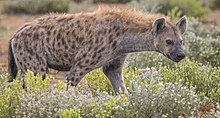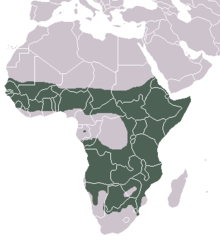| Spotted hyena Temporal range: ~Early Pleistocene-Present
| |
|---|---|

| |
| At Etosha National Park, Namibia | |
| Whooping recorded in Umfolozi Game Reserve, South Africa | |
| Scientific classification | |
| Domain: | Eukaryota |
| Kingdom: | Animalia |
| Phylum: | Chordata |
| Class: | Mammalia |
| Order: | Carnivora |
| Suborder: | Feliformia |
| Family: | Hyaenidae |
| Genus: | Crocuta |
| Species: | C. crocuta
|
| Binomial name | |
| Crocuta crocuta (Erxleben, 1777)
| |

| |
| range | |
| Synonyms | |
|
Species synonymy[2]
| |
The spotted hyena (Crocuta crocuta), also known as the laughing hyena,[3] is a hyena species, currently classed as the sole extant member of the genus Crocuta, native to sub-Saharan Africa. It is listed as being of least concern by the IUCN due to its widespread range and large numbers estimated between 27,000 and 47,000 individuals.[1] The species is, however, experiencing declines outside of protected areas due to habitat loss and poaching.[1] Populations of Crocuta, usually considered a subspecies of Crocuta crocuta, known as cave hyenas, roamed across Eurasia for at least one million years until the end of the Late Pleistocene.[4] The spotted hyena is the largest extant member of the Hyaenidae, and is further physically distinguished from other species by its vaguely bear-like build,[5] rounded ears,[6] less prominent mane, spotted pelt,[7] more dual-purposed dentition,[8] fewer nipples,[9] and pseudo-penis. It is the only placental mammalian species where females have a pseudo-penis and lack an external vaginal opening.[10]
The spotted hyena is the most social of the Carnivora in that it has the largest group sizes and most complex social behaviours.[11] Its social organisation is unlike that of any other carnivore, bearing closer resemblance to that of cercopithecine primates (baboons and macaques) with respect to group size, hierarchical structure, and frequency of social interaction among both kin and unrelated group-mates.[12] However, the social system of the spotted hyena is openly competitive rather than cooperative, with access to kills, mating opportunities and the time of dispersal for males depending on the ability to dominate other clan-members. Females provide only for their own cubs rather than assist each other, and males display no paternal care. Spotted hyena society is matriarchal; females are larger than males, and dominate them.[13]
The spotted hyena is a highly successful animal, being the most common large carnivore in Africa. Its success is due in part to its adaptability and opportunism; it is primarily a hunter but may also scavenge, with the capacity to eat and digest skin, bone and other animal waste. In functional terms, the spotted hyena makes the most efficient use of animal matter of all African carnivores.[14] The spotted hyena displays greater plasticity in its hunting and foraging behaviour than other African carnivores;[15] it hunts alone, in small parties of 2–5 individuals or in large groups. During a hunt, spotted hyenas often run through ungulate herds to select an individual to attack. Once selected, their prey is chased over a long distance, often several kilometres, at speeds of up to 60 kilometres per hour (37 mph).[16]
The spotted hyena has a long history of interaction with humanity; depictions of the species exist from the Upper Paleolithic period, with carvings and paintings from the Lascaux and Chauvet Caves.[17] The species has a largely negative reputation in both Western culture and African folklore. In the former, the species is mostly regarded as ugly and cowardly, while in the latter, it is viewed as greedy, gluttonous, stupid, and foolish, yet powerful and potentially dangerous. The majority of Western perceptions on the species can be found in the writings of Aristotle and Pliny the Elder, though in relatively unjudgmental form. Explicit, negative judgments occur in the Physiologus, where the animal is depicted as a hermaphrodite and grave-robber.[18] The IUCN's hyena specialist group identifies the spotted hyena's negative reputation as detrimental to the species' continued survival, both in captivity and the wild.[18][19]
- ^ a b c Bohm, T.; Höner, O.R. (2015). "Crocuta crocuta". IUCN Red List of Threatened Species. 2015: e.T5674A45194782. doi:10.2305/IUCN.UK.2015-2.RLTS.T5674A45194782.en. Retrieved 19 November 2021.
- ^ Wozencraft, W. C. (2005). "Order Carnivora". In Wilson, D. E.; Reeder, D. M. (eds.). Mammal Species of the World: A Taxonomic and Geographic Reference (3rd ed.). Johns Hopkins University Press. p. 572. ISBN 978-0-8018-8221-0. OCLC 62265494.
- ^ Cite error: The named reference
f55was invoked but never defined (see the help page). - ^ Cite error: The named reference
varelawas invoked but never defined (see the help page). - ^ Estes 1998, p. 290
- ^ Cite error: The named reference
r355was invoked but never defined (see the help page). - ^ Cite error: The named reference
r353was invoked but never defined (see the help page). - ^ Macdonald 1992, pp. 134–135
- ^ Cite error: The named reference
dreawas invoked but never defined (see the help page). - ^ Cite error: The named reference
differentiationwas invoked but never defined (see the help page). - ^ Mills & Hofer 1998, p. 34
- ^ Cite error: The named reference
Journalwas invoked but never defined (see the help page). - ^ Estes 1992, pp. 337–338
- ^ Kingdon 1988, p. 262
- ^ Kingdon 1988, p. 264
- ^ Mills & Hofer 1998, p. 33
- ^ Spassov, N.; Stoytchev, T. (2004). "The presence of cave hyaena (Crocuta crocuta spelaea) in the Upper Palaeolithic rock art of Europe" (PDF). Historia Naturalis Bulgarica. 16: 159–166. Archived from the original (PDF) on 15 April 2012.
- ^ a b Glickman, Stephen (1995). "The Spotted Hyena from Aristotle to the Lion King: Reputation is Everything – In the Company of Animals", Social Research, Volume 62
- ^ Mills & Hofer 1998, p. 92 & 101
